| | | |
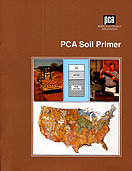
|
An introduction to soil engineering properties and the influence of soil
on design, construction, and performance of pavements. Includes definitions of
soil terms and tests commonly used by soil technicians, with particular emphasis
on the practical meaning and application of these terms and tests. Describes
soil surveys and sampling; soil-bearing value tests; and examples of soil
surveys, tests, and analyses.
|
|
Item Code:
|
EB007
|
|
Price:
|
$15.00
|
|
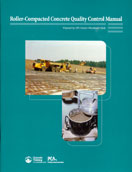
|
This 58-page publication provides general guidelines for establishing a
field quality control program for the production and placement of
roller-compacted concrete (RCC). Prepared primarily for the use of RCC in dam
and overtopping spillway applications, the manual can also be useful for
heavy-duty pavement and storage area type projects. Tables and figures are
included to illustrate various key elements in a typical QC program. Also
included are several sample data recording forms and worksheets.
|
|
Item Code:
|
EB215
|
|
Price:
|
$20.00
|
|
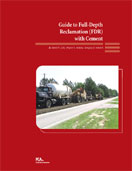
|
A revised and current comprehensive guide to Full-Depth Reclamation (FDR)
using cement. FDR is a roadway rehabilitation process that recycles the
materials from deteriorated asphalt pavement, and, with the addition of portland
cement, creates a new stabilized base. The addition of a new concrete or
bituminous riding surface completes the FDR process, providing a new roadway
structure using recycled materials from the failed pavement.
This document describes the step-by-step process, from initial site
investigation, to mix design, and construction. A recommended construction
specification for FDR is included.
|
|
Item Code:
|
EB234
|
|
Price:
|
$25.00
|
|
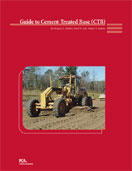
|
Cement-treated base (CTB) is a general term that applies to a mixture of
native soils and/or manufactured aggregates with measured amounts of portland
cement and water. The soil is then compacted and cured to form a strong,
durable, and frost-resistant paving material. Other descriptions such as
soil-cement base, cement-treated aggregate base, or cement-stabilized base are
sometimes used.
This document provides a basic guide on the use of cement-treated base (CTB) for pavement applications. It provides an overview on the design and construction of CTB for both mixed-in-place and central plant mixed operations. A suggested construction specification is also included.
|
|
Item Code:
|
EB236
|
|
Price:
|
$25.00
|
|
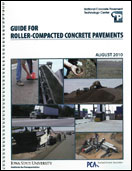
|
Roller-compacted concrete (RCC) is an economical, fast-construction
candidate for many pavement applications. It has traditionally been used for
pavements carrying heavy loads in low-speed areas because of its relatively
coarse surface. However, in recent years its use has expanded into commercial
areas and local streets and highways.
This guide provides owner-agencies, contractors, material suppliers, and
others with a thorough introduction to RCC and its many applications. Based on
current research and best practices, the guide provides detailed overviews of
RCC properties and materials, mixture proportioning, structural design, and
production and construction considerations, plus troubleshooting guidelines and
an extensive reference list for more comprehensive
information.
|
|
Item Code:
|
SN298
|
|
Price:
|
$12.00
|
|

|
Roller-compacted concrete (RCC) is an economical, fast-construction
candidate for many pavement applications. It has traditionally been used for
pavements carrying heavy loads in low-speed areas because of its relatively
coarse surface. However, in recent years its use has expanded into commercial
areas and local streets and highways.
This guide provides owner-agencies, contractors, material suppliers, and
others with a thorough introduction to RCC and its many applications. Based on
current research and best practices, the guide provides detailed overviews of
RCC properties and materials, mixture proportioning, structural design, and
production and construction considerations, plus troubleshooting guidelines and
an extensive reference list for more comprehensive
information.
|
|
Item Code:
|
SN298
|
|
Price:
|
$0.00
|
|
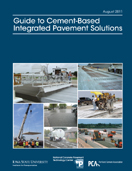
|
This guide provides a clear, concise, and cohesive
presentation of cement-bound materials options for 10specific engineering
pavement applications: new concrete pavements, concrete overlays, pervious
concrete, precast pavements, roller-compacted concrete, cement-treated base,
full-depth reclamation with cement, cement-modified soils, recycled concrete
aggregates, and repair and restoration.
Each application is presented as a method for meeting
specific design and construction objectives that today’s pavement practitioners
must accomplish. The benefits, considerations, brief description, and summary of
materials, design, and construction requirements, as well as a list of
sustainable attributes, are provided for every solution.
This guide is intended to be short, simple, and easy to
understand. It was designed so that the most up-to-date and relevant information
is easily extractable. It is not intended to be used as a design guide for any
of the applications identified herein. Recommendations for additional
information that can provide such details are given at the end of each solution
discussion.
The intended audience is practitioners, including
engineers and managers who face decisions regarding what materials to specify in
the pavement systems they design or manage. The audience also includes city and
county engineers, along with the A/E firms that often represent them, and state
DOT engineers at all levels who are seeking alternatives in this era of changing
markets.
Limit of 5 free publications. (Pay shipping only.) For
larger quantities, contact Customer Service at
847.972.9150. .
|
|
Item Code:
|
SR035
|
|
Price:
|
$0.00
|
|
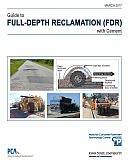
|
This Guide to Full-Depth
Reclamation (FDR) with Cement is a
product of the National Concrete Pavement Technology Center (CP Tech Center) at
Iowa State University’s Institute for Transportation, with funding from the
Portland Cement Association. The guide provides a concise discussion of all
aspects of selecting, designing, and constructing a reclaimed, cement-stabilized
asphalt base in preparation for a new pavement surface layer.
As the nation’s infrastructure
ages, agencies at all levels are tasked with maintaining and rehabilitating
their infrastructure. Sustainable engineering technologies in pavement
rehabilitation, such as full-depth reclamation (FDR), could be the answer for
agencies in their quest to provide taxpayers with high-quality infrastructure
while being good stewards of public funds. Full-depth reclamation of asphalt
pavement is a rehabilitation method that involves recycling an existing asphalt
pavement and its underlying layer(s) into a new base layer. The FDR process
begins with using a road reclaimer to pulverize an existing asphalt pavement and
a portion of the underlying base, subbase, and/or subgrade. Usually the
pulverized material is uniformly blended with an additional stabilizing material
such as cement to provide an upgraded, homogeneous material. Finally, the
stabilized material is compacted in place with rollers. The result is a stiff,
stabilized base that is ready for a new rigid or flexible surface course. This
guide introduces the FDR with cement process and discusses issues related to
project selection, design, construction and testing/quality control.
|
|
Item Code:
|
SR1006P
|
|
Price:
|
$0.00
|
|

|
Fuel
consumption due to pavement-vehicle interaction (PVI) is an essential part of
life-cycle assessment (LCA) of pavement systems. In general, roughness and
deflection of a pavement are considered as the main contributors to PVI. Some
estimates attribute up to 70% of greenhouse gas emissions (GHG) to PVI due to
the unavoidable deflection of pavements when subjected to vehicle load.
Various empirical studies have looked at the impact of pavement
deflection on fuel consumption; however, their main focus has been on a binary
material view of asphalt versus concrete pavement, with no consideration of the
relationship between pavement deflection and its structure and material.
Research conducted by MIT used a mechanistic approach to draw a
relationship between pavement structure and material with its deflection, and
creates a link between pavement properties and the impact of PVI on fuel
consumption. To achieve this goal, the work involved a model calibration and
validation for pavement deflection values, estimated fuel consumption caused by
the deflection basin, and compared the results to that of existing field data.
The use of a first-order mechanistic model allowed for the identification of key
design parameters to down-size fuel consumption due to PVI. Results from this
modeling predicted that asphalt overlays need to be 25-60% thicker to display
the same fuel consumption performance as concrete.
This free webinar
will review the various empirical studies that have been conducted related to
PVI and discuss some of the uncertainties associated with these studies. A
mechanistic model will be presented that considers the role deflection plays in
fuel consumption and results from the model will be compared to some of the more
recent empirical PVI studies.
Program features:
- PDF of MIT report Methods, Impacts, and Opportunities
in the Concrete Pavement Life Cycle
- PDF copy of the presentation
|
|
Item Code:
|
WB048
|
|
Price:
|
$0.00
|
|
|